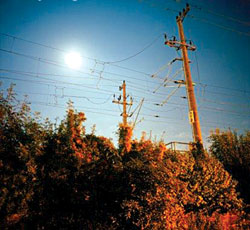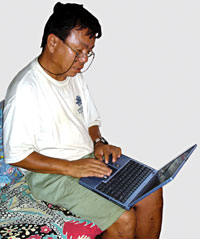 Last week parliament's Development Committee issued a long overdue directive. The much-used 2.4 and 5.8 wireless frequency bands could become legal for use. The directive also mentions legalising VoIP (Voice over IP), a telephony option that could rapidly bring communications to remote areas. The announcement must appear in the Gazette to come into force.
Last week parliament's Development Committee issued a long overdue directive. The much-used 2.4 and 5.8 wireless frequency bands could become legal for use. The directive also mentions legalising VoIP (Voice over IP), a telephony option that could rapidly bring communications to remote areas. The announcement must appear in the Gazette to come into force.
VoIP has been legalised since the late 1990s in many countries, and is especially good for Nepal. Phone tariffs could drop considerably, and together with wireless internet service, VoIP is a relatively quick way to extend telephony to remote and rural areas of the country.
The de-licensing of wireless frequencies comes late in the day. In Nepal, if you use the WiFi feature on your laptop, you're a scofflaw. Unless, that is, you pay the Rs 6,000 annual license fee, which most don't know about. The 2.4 and 5.8 frequency bands most consumer wireless cards on laptops and desktops use are restricted in Nepal.
These should be unregulated frequencies, as the International Telecommunications Union designates them as Industrial, Scientific and Medical Bands frequencies on a non-protection and interference acceptance basis. Most countries, barring a few like North Korea, allow unrestricted public use of these frequencies.
The directive came following serious lobbying by Mahabir Pun of the Nepal Wireless Project (see box) and hobbyists.
There are undertakings like Pun's Nepal Wireless Project and private businesses that use the two bands. Pun has been open about having 'illegal' equipment handcarried into the country by volunteers. But this means he has to send damaged equipment abroad to be fixed, taking some villages offline for weeks. The new regulations will help projects like Pun's, and help establish benchmarking for ISPs and other telecom businesses.
Changing regulations is difficult as the Nepal Telecommunications Authority is often toothless, and frequencies are regulated by an unwiedly committee headed by the Minister for Communications and including secretaries of Home, Communications, Defence, Tourism, and the NTA chair. But after this come more difficult issues, such as harmonising the licensing regime and bringing import regulations and duties in line with telecom policy.
Nepal's telecom policies are based on a 50-year-old regulatory framework. This stops even public institutions from using expensive equipment. The much-touted 1500 telecentre project of the Ministry of Science and Technology was established in Mustang, and then held hostage to the licensing regime.
The World Bank gave the Nepal Wireless Project a grant from its national Poverty Alleviation Fund (PAF) last year, but didn't push for legislative change. Very soon, the project will end up on the list of 'success stories' to be replicated, whilst it cannot even be replicated in Nepal itself.
Wireless villages
|
|
Mahabir Pun knows the value of education. His father, a retired Indian Army solider, sold the family home and land to send Pun to school. Mahabir earned his ISc in Kathmandu and won two scholarships to get a bachelor's and then a master's degree in the United States, in Nebraska. He wanted to return the favour on a larger scale, and after he finished university, Pun went straight back home to Naangigaun, Myagdi, to give the school there a new lease on life. He ended up doing a little more than planned.
About five years ago, most international reports on his work focused on the novelty factor-running a computer out of a wooden box amid the Himalayas. But today the Nepal Wireless Project in mid-western Nepal is a model of a simple, effective, and successful rural internet access.
In five years, the Project has connected some 22 neighbouring villages in Myagdi and Parbat at a cost of Rs 2 million. It's an efficient wireless network that uses, among other technical options, a single telephone line originating in Pokhara to serve 15 villages. The local network and internet are used to exchange information about locally produced goods and commodity prices, as well as other programs and weekly markets. The wireless network also provides telemedicine facilities to eight villages using doctors from Pokhara's Om Hospital.
The service is probably slow and there is room for improvement, but Pun's model is proof that villages don't have to wait for landlines for communication or improved services. The internet is not, as commonly believed, a luxury or irrelevant entertainment in poor rural areas-as long as access is simple, use is directed, and services and content are customised. Observers from Palpa, Gorkha, and Mustang districts have requested Pun to help them set up similar wireless networks in these areas too.
Pun has lobbied hard for the de-licensing of the 2.4 and 5.8 frequency bands, but says that telecom regulations as a whole need to be updated. "How can 50-year-old laws apply to 21st century technology?" he asks.



